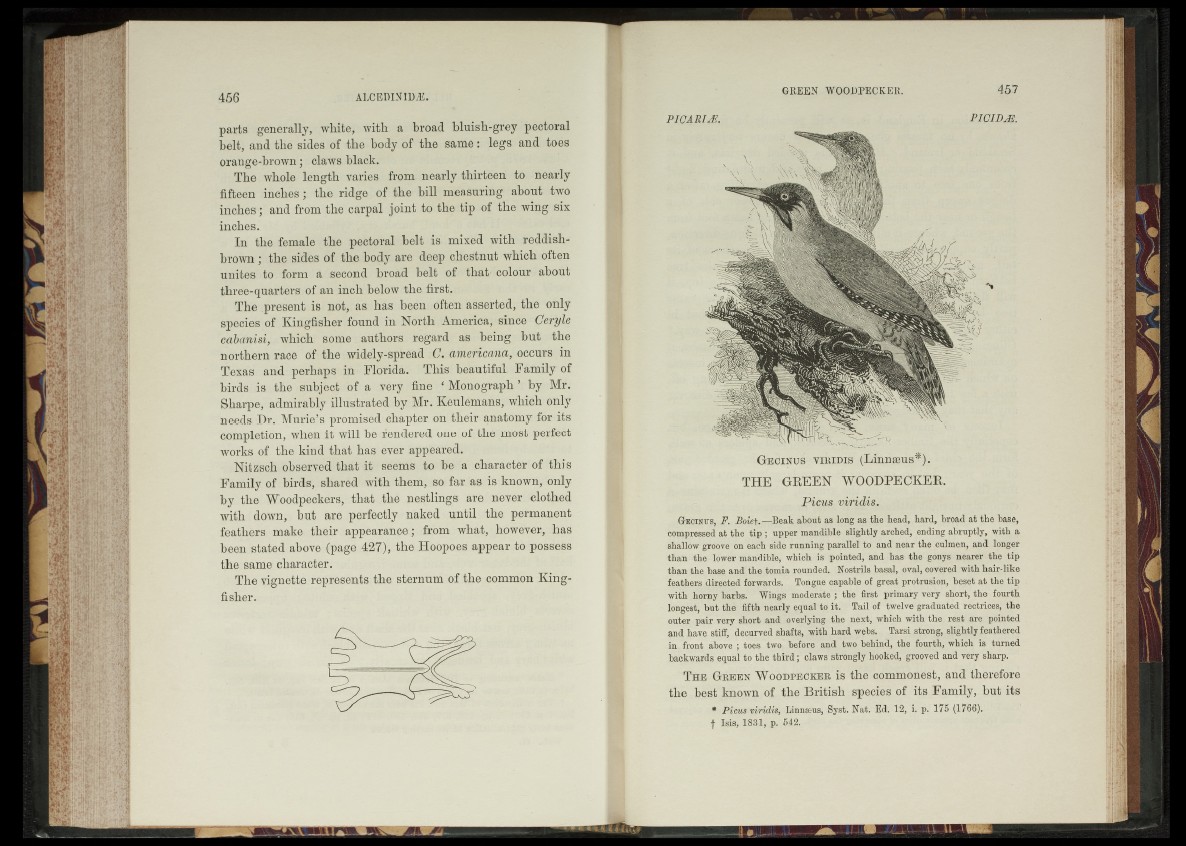
parts generally, white, with a broad bluish-grey pectoral
belt, and the sides of the body of the same: legs and toes
orange-brown; claws black.
The whole length varies from nearly thirteen to nearly
fifteen inches; the ridge of the hill measuring about two
inches; and from the carpal joint to the tip of the wing six
inches.
In the female the pectoral belt is mixed with reddish-
brown ; the sides of the body are deep chestnut which often
unites to form a second broad belt of that' colour about
three-quarters of an inch below the first.
The present is not, as has been often asserted, the only
species of Kingfisher found in North America, since Ceryle
cabatiisi, which some authors regard as being but the
northern race of the widely-spread C. americana, occurs in
Texas and perhaps in Florida. This beautiful Family of
birds is the subject of a very fine ! Monograph ’ by Mr.
Sharpe, admirably illustrated by Mr. Keulemans, which only
needs Dr. Murie’s promised chapter on their anatomy tor its
completion, when it will he rendered one of the most perfect
works of the kind that has ever appeared.
Nitzsch observed that it seems to he a character of this
Family of birds, shared with them, so far as is known, only
by the Woodpeckers, that the nestlings are never clothed
with down, hut are perfectly naked until the permanent
feathers make their appearance; from what, however, has
been stated above (page 427), the Hoopoes appear to possess
the same character.
The vignette represents the sternum of the common Kingfisher.
PIOARI^E. PICIBjE.
G e c i n u s v i r i d i s (Linnaeus*).
THE GREEN WOODPECKER.
Picus viridis.
Gecintts, F. B o i e f .— B e a k ab out as lon g a s tb e h ead , hard, broad a t th e b ase,
compressed a t th e t ip ; u pp er m an d ib le s lig h tly arched, en d in g ab ruptly, w ith a
sh a llow groove on each sid e ru n n in g p a ra llel to and near th e cu lm en , and longer
th a n th e low er m an d ib le , w h ich is p o in ted , and h a s th e gonys nearer th e tip
th a n th e base and th e tom ia rounded. N o str ils b asal, o val, covered w ith h a ir -lik e
fe a th e r s d ir e c ted forwards. Tongue capable of grea t p rotrusion, b e s e t a t th e t ip
w ith h o rn y barbs. W in g s modera te ; th e first p rimary v er y sho r t, th e fou r th
lon g est, b u t th e fifth nea rly eq u a l to it . T a il o f tw e lv e grad u a ted re ctric es, th e
ou ter p a ir v er y sho r t and o v e r ly in g th e n e x t, which w ith th e r e st are p o in ted
and h a v e stiff, decu rv ed sh a fts, w ith h a rd web s. Ta rsi strong, s lig h tly fea th e r ed
in front ab ove ; to e s tw o befo re an d tw o b eh in d , th e fourth, w h ich is tu rn ed
b a ckwards eq u a l to th e t h ir d ; c law s stron g ly hooked, grooved and v er y sharp.
T h e G r e e n W o o d p e c k e r is the commonest, and therefore
the best known of the British species of its Family, hut its
* Picus viridis, Linnaeus, S y st. N a t. Ed. 1 2 , i. p. 1 7 5 (1 7 6 6 ).
f I s is , 1 8 3 1 , p. 5 4 2 .